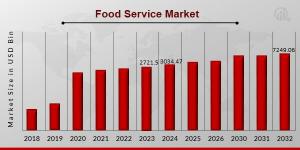Rising desire for food consumed outside the house.Increased demand in plant-based, vegetarian, and vegan protein choices
NEW YORK, NY, UNITED STATES, February 17, 2025 /EINPresswire.com/ — The global Food Service Market has seen substantial growth in recent years and is expected to continue expanding at an impressive rate. Valued at USD 2,721.5 billion in 2023, the food service industry is projected to reach USD 7,249.07 billion by 2032, growing at a compound annual growth rate (CAGR) of 11.50% from 2024 to 2032. The market's expansion is attributed to several factors, including the rising demand for convenience, a shift towards healthier eating, and a greater inclination towards dining out. The food service industry encompasses a broad range of establishments, including full-service restaurants, quick-service restaurants (QSR), catering services, and food delivery services. It also spans across commercial and institutional service types, serving a diverse consumer base.
This market is influenced by a variety of consumer preferences, technological advancements, and changing lifestyles, all of which will shape the landscape of the food service industry in the years to come. The Food Service Market is segmented by type, service type, and region, each contributing to the overall growth and expansion.
Key Players:
McDonald's (Illinois – United States), Hilton Worldwide (Virginia – U.S.), Starbucks (Washington – U.S.), Marriott International (Maryland – U.S.), KFC (Kentucky – U.S.), Burger King (Florida – U.S.), Subway (Connecticut – U.S.), Pizza Hut (Texas – U.S.), Hyatt Hotels Corporation (Illinois – U.S.), Domino's (Michigan – U.S.), and Others
"Request Free Sample" – Obtain a complimentary sample of our report to assess its quality and relevance to your requirements: https://www.marketresearchfuture.com/sample_request/11595
Market Segmentation
By Type
The food service industry is divided into several categories, with the primary types being full-service restaurants, quick-service restaurants (QSR), institutions (such as schools and hospitals), and other food service providers. Each of these segments plays a crucial role in the market's growth and overall success.
Full-Service Restaurants: These establishments, which include casual dining, fine dining, and family-style restaurants, continue to dominate the market. They offer an immersive dining experience, and consumer demand for high-quality food and personalized service is a major driver of growth. With rising disposable incomes and a greater focus on dining experiences, full-service restaurants are expected to see a consistent demand globally.
Quick-Service Restaurants (QSR): The quick-service segment, often characterized by fast food chains and take-out services, has witnessed a surge in demand due to the increasing preference for fast, affordable, and convenient food options. QSRs are projected to see robust growth over the forecast period, especially as consumers increasingly look for value for money and time-saving options.
Institutes and Others: The institutional segment includes food service providers in sectors like schools, hospitals, corporate cafeterias, and other institutions. This segment has seen strong growth due to the increasing demand for institutional catering services, driven by large numbers of people requiring food services on a daily basis.
By Service Type
The food service market can also be segmented based on service type, specifically into two categories: commercial and institutional.
Commercial Food Services: These include all privately owned establishments such as restaurants, catering services, and other hospitality venues. The commercial sector is largely driven by consumer spending, dining trends, and an increasing appetite for unique and gourmet food experiences. Commercial services are projected to lead the market during the forecast period, given the growth in disposable income and the rising demand for dining out.
Institutional Food Services: This category involves food services provided in institutions such as schools, universities, hospitals, military, and correctional facilities. Institutional food service providers are usually less impacted by economic fluctuations as their clientele is guaranteed by the institutional setting. The increasing need for nutritious, convenient, and cost-effective food services is likely to drive significant growth in this segment.
By Region
The food service market exhibits notable regional variation, influenced by local preferences, economic factors, and cultural norms. The key regions in the global food service market include North America, Europe, Asia-Pacific, and the Rest of the World.
North America: North America is one of the largest markets for food service, driven by the robust economy, high disposable incomes, and a growing culture of dining out. The U.S., in particular, has a diverse range of food service types, from fast food to fine dining, and is witnessing strong growth in the delivery and takeaway sectors. Innovations in food technology, such as delivery apps and cloud kitchens, are expected to further fuel growth in this region.
Europe: Europe is home to a large and varied food service sector, with an increasing shift towards healthier dining options and sustainable food choices. The popularity of fast casual dining and organic food is growing, while traditional European cuisine remains a major draw for tourists. In addition, technological advancements in food ordering and delivery are expected to help expand the market across the continent.
Asia-Pacific: The Asia-Pacific region is anticipated to be the fastest-growing market for food services. With rising urbanization, disposable incomes, and changing consumer preferences, the demand for food service offerings, particularly quick-service restaurants and institutional food services, is on the rise. In countries like China, India, and Japan, the adoption of modern food service models, including delivery services and cloud kitchens, is contributing to the market's rapid growth.
Rest of the World: The Rest of the World, including regions like the Middle East, Africa, and Latin America, is experiencing a gradual but steady increase in food service demand. While these regions may have smaller market sizes compared to the aforementioned regions, they offer significant potential for future growth, particularly in sectors like QSRs and institutional food services.
"Proceed to Buy" – Move forward with your purchase and gain instant access to the complete report: https://www.marketresearchfuture.com/checkout?currency=one_user-USD&report_id=11595
Industry Developments
The food service market has been undergoing several transformations in recent years, driven by changes in consumer behavior, technological advancements, and the global pandemic's lasting effects. The surge in food delivery and takeaway services is one of the key developments in the market, as consumers increasingly demand convenience, speed, and ease of access to food.
Innovations in food technology have also played a crucial role in reshaping the industry. The rise of online food ordering platforms and food delivery apps, along with the emergence of cloud kitchens and ghost kitchens, has made it easier for consumers to access a wide range of food options from the comfort of their homes. The use of digital payment systems, contactless ordering, and AI-driven recommendations are becoming commonplace, enhancing the overall dining experience.
Additionally, food safety and sustainability have become top priorities for many food service providers. The increasing demand for eco-friendly packaging, plant-based menu options, and locally sourced ingredients is a direct response to consumers’ growing awareness of environmental and health concerns. Companies are also embracing health-conscious food trends, with plant-based, organic, and gluten-free options becoming more prevalent on menus.
Market Drivers and Challenges
The growth of the food service market is supported by several key drivers:
Changing Lifestyles: With an increasing focus on convenience and a fast-paced lifestyle, consumers are opting for quick and easy meal options, driving the growth of QSRs and food delivery services.
Rising Disposable Incomes: Higher disposable incomes, especially in emerging markets, allow consumers to spend more on dining out and premium food experiences.
Technological Advancements: Innovations such as mobile ordering apps, AI-powered services, and food delivery platforms are enhancing consumer experiences and increasing market accessibility.
Health Consciousness: There is a growing demand for healthier, more sustainable food options, which has led to the development of health-focused menus and organic food offerings.
"Browse Report" – Explore the report's contents, sections, and key insights by browsing through its detailed information: https://www.marketresearchfuture.com/reports/food-service-market-11595
However, the food service market faces a number of challenges that may hinder its growth:
Labor Shortages: The food service industry is experiencing significant labor shortages, with many establishments struggling to find and retain qualified workers.
Economic Instability: While the food service sector is relatively resilient, economic downturns can still impact consumer spending on dining out and luxury food experiences.
Supply Chain Disruptions: The global supply chain issues, particularly post-pandemic, have caused disruptions in food sourcing and ingredient availability, leading to higher costs and lower profit margins for food service providers.
1 EXECUTIVE SUMMARY
2 MARKET INTRODUCTION
3 RESEARCH METHODOLOGY
4 MARKET DYNAMICS
5 MARKET FACTOR ANALYSIS
6 FOOD SERVICE MARKET, BY FORM
7 FOOD SERVICE MARKET, BY CATEGORY
8 FOOD SERVICE MARKET, BY APPLICATION
9 FOOD SERVICE, BY REGION
10 COMPETITIVE LANDSCAPE
Discover more Research Reports on Food, Beverages & Nutrition Industry, by Market Research Future:
wheat straw Market : https://www.marketresearchfuture.com/reports/wheat-straw-market-38422
whipped butter Market : https://www.marketresearchfuture.com/reports/whipped-butter-market-38423
whipping agent Market : https://www.marketresearchfuture.com/reports/whipping-agent-market-38424
white wheat malt Market : https://www.marketresearchfuture.com/reports/white-wheat-malt-market-38427
whole grain drink Market : https://www.marketresearchfuture.com/reports/whole-grain-drink-market-38428
wine capsule Market : https://www.marketresearchfuture.com/reports/wine-capsule-market-38429
About Market Research Future:
Market Research Future (MRFR) is a global market research company that takes pride in its services, offering a complete and accurate analysis with regard to diverse markets and consumers worldwide. Market Research Future has the distinguished objective of providing optimal quality research and granular research to clients. Our market research studies by products, services, technologies, applications, end users, and market players for global, regional, and country level market segments, enable our clients to see more, know more, and do more, which help answer your most important questions.
Contact Us:
Market Research Future (Part of Wantstats Research and Media Private Limited)
99 Hudson Street, 5Th Floor
New York, NY 10013
United States of America
+1 628 258 0071 (US)
+44 2035 002 764 (UK)
Email: sales@marketresearchfuture.com
Website: https://www.marketresearchfuture.com
Market Research Future
Market Research Future
+1 855-661-4441
email us here
Visit us on social media:
Facebook
X
LinkedIn
Legal Disclaimer:
EIN Presswire provides this news content “as is” without warranty of any kind. We do not accept any responsibility or liability
for the accuracy, content, images, videos, licenses, completeness, legality, or reliability of the information contained in this
article. If you have any complaints or copyright issues related to this article, kindly contact the author above.
![]()

